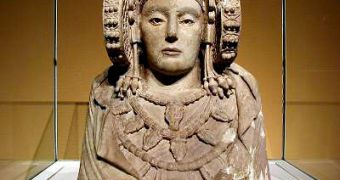Today, the word "Iberian" makes you think about Spain and Portugal, but the word comes from the name of an ancient population that inhabited the southern and eastern Iberian Peninsula in Antiquity. Historical sources starting with the 5th century BC describe the barbarian inhabitants of "Hispania", with odd habits and bloody rituals. The Iberian tribes lived in settlements located on the top of the hills, in strategic places, dominating the valleys of the rivers. Each settlement was surrounded by defensive stone walls.
The Iberians are the oldest historically known inhabitants of the Iberian Peninsula. They were non Indo-European, rather short and dark haired. Men wore beards and long hair. Iberian raised cattle, pigs and sheep and cultivated the land. Their origin is unknown. Some say they could have been related to the North African Berber tribes. Others say that they rather came from Asia Minor or Caucasus during a pre-Indo-European migration, some 10,000 years ago, and this could be confirmed by dolmens, large stone tombs. In historical times, they formed small tribal states governed by assemblies, in a republican type of state, which decided war, peace or questions of general interest. In the historical times, the Mediterranean coasts inhabited by Iberians were colonized by Phoenicians, Greeks and Carthaginians, and these colonies raised the civilization level of the Iberians. This way, the Iberians knew the potter's wheel and produced sophisticatedly adorned ceramics by themselves. The foreign traders exchanged pottery and glass collars for Iberian gold, silver, copper, tin and agricultural products.
Iberians were skilled riders and each tribe had a chivalry unit. The main weapons were the bow and the arrows, falcata (a slightly curved one-bladed sword), the shield, the helmet and the large spear (the Iberian sword and spear would later be adopted by Romans). The horse must have been introduced to Iberians by Indo-Europeans populations around 1,000 BC. When Romans conquered the peninsula, they introduced units of Iberian chivalry in the Roman army.
Iberians worshiped many deities of natural type (Sun, Moon, various stars) in whose honor they maintained fires in certain promontories, capes and islands. Another type of sanctuaries were visited by people offering bronze figurines (exvotos) to the god living inside the sanctuaries, asking for supernatural help in various tasks, for curing a disease or simply to thank for received favors.
Iberian women were charged with domestic tasks, husbandry of small livestock and cultivated the land together with the men. In some tribes, they participated in the assemblies, and their decision was considered in important issues. Sometimes, women fought together with the men. In the Iberian society, women could also be priestesses. The famous Iberian carving called Lady of Elx, dated from the 3rd century BC and made of limestone, could represent a priestess. The woman wears several collars, and large wheel shaped earrings. A belt hides the hair, probably made into a bun.
Wars between tribes were frequent. Romans managed to conquest the Iberian fortresses only after long sieges (months, even years) that left hungry and exhausted the besieged warriors. Romans built a palisade around the circumvented fortress, which impeded the beleaguered Iberians to break the circle looking for help.
Iberians exploited copper and tin, and also collected gold and silver nuggets on the rivers' banks. Iron was brought by navigators (this metal was discovered by Indo-Europeans) and soon the Iberians started iron metallurgy.

 14 DAY TRIAL //
14 DAY TRIAL //